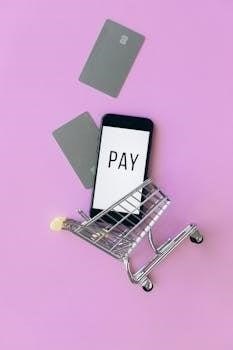Credit Card Worksheet for Students⁚ An Overview
Credit cards offer students increased purchasing power and the opportunity to build a solid credit history. Student credit cards can be a great way to start building credit as an 18-year-old.

Understanding Credit Cards
Credit cards are financial tools that allow users to borrow money. When you use a credit card, you are borrowing money from your bank. Students may use credit cards for educational purposes.
How Credit Cards Work
Credit cards function as a short-term loan from a financial institution. When you make a purchase using a credit card, the issuer pays the merchant, and you accrue a balance that you must repay; Each month, you receive a statement outlining your charges, payments, and the total amount due. You have the option to pay the full balance, a minimum payment, or any amount in between.
However, carrying a balance incurs interest charges, which are calculated as a percentage of the outstanding amount. The interest rate is typically expressed as an annual percentage rate (APR). If you pay the full balance each month, you avoid interest charges altogether. Credit cards also come with a credit limit, which is the maximum amount you can charge to the card. Staying within your credit limit is important for maintaining a good credit score.
Benefits of Using Credit Cards
Using credit cards responsibly offers several benefits for students. Firstly, it’s a great way to start building credit, which is essential for future financial endeavors like renting an apartment or getting a car loan. With a responsible approach, you can establish a good credit history.
Secondly, many credit cards offer rewards programs, such as cash back or travel points, that can help you save money on everyday purchases. Thirdly, credit cards provide a convenient way to track expenses and manage your budget. Credit card statements offer a detailed record of your spending, making it easier to monitor where your money is going. Also, credit cards can be useful in emergencies, providing access to funds when needed.

Credit Card Basics for Students
Student credit cards are designed for undergraduate, graduate, and non-traditional student borrowers looking to establish good credit habits while pursuing their education. It is a good way to start.
Building Credit History
Establishing a credit history is a crucial step towards financial independence, and a student credit card can be a powerful tool in this process. By responsibly managing a credit card, students can demonstrate their ability to handle credit and build a positive credit score. This, in turn, can open doors to various financial opportunities in the future, such as securing loans for a car or a home, renting an apartment, or even obtaining better insurance rates.
Using a credit card and paying it back consistently at the end of each month is a great way to start building credit, especially for international students who don’t have a credit history in the US. It’s essential to make timely payments and keep credit utilization low to positively impact credit scores.
Student Credit Card Eligibility
Student credit cards are specifically designed to give those with a low income a good chance at being approved. Student card issuers know students often have limited income, so they often have less strict qualification criteria than those for traditional non-student cards.
Eligibility for student credit cards often hinges on factors beyond just income. While federal law requirements make it hard for people under 21 to get a credit card, students enrolled in higher education institutions can often qualify more easily. Some issuers have agreements with institutes of higher education, further easing the approval process. Getting a student credit card is an important first step in establishing your credit as a beginner.
Responsible Credit Card Use
Equipping teens with the knowledge and skills to navigate the realm of plastic is crucial for their financial future. As you start slow and allow them to practice making smart decisions.
Budgeting and Spending Habits
Open communication is the cornerstone of financial education. By managing your own credit card account, you can gain experience in handling credit and budgeting. Student credit cards can be a great way to start building credit. Teens Credit Card is a Northwest Youth Financial Education program designed to teach young adults about the realities of how credit cards work. A student credit card can be a step toward greater financial independence.
Cards, Cars and Currency is a curriculum unit that challenges students to become involved in three specific areas of personal finance. Teach your kids credit card lessons by letting them make small purchases and practice paying them off. Machine learning represents a … accurately predicting churn risk. Featured workshop⁚ Credit cards and prepaid cards In this workshop, you will learn the advantages and disadvantages of credit cards.
Avoiding Debt and Managing Payments
As you start slow and allow them to practice making smart and responsible decisions, they’ll be more likely to do the right thing when they have their own card. Using credit early is educational and can teach them to avoid debt and manage payments responsibly. Student credit cards are specifically designed to give those with a low income a good chance at being approved.
Opening a college student credit card is a smart way to start building credit early while taking advantage of rewards and special financing offers. Teens having access to credit cards has both advantages and disadvantages. Federal law requirements make it hard for people under 21 to get a credit card. Students must understand financial literacy to avoid debt.

Credit Card Worksheet Activities
Cards, Cars and Currency is a curriculum unit that challenges students to become involved in personal finance. The activities in each lesson plan are designed to address specific areas.
Tracking Expenses and Credit Card Statements
One crucial activity involves meticulously tracking expenses. This can be achieved through spreadsheets, budgeting apps, or even a simple notebook. Regularly recording every purchase made with the credit card provides a clear overview of spending habits. Analyzing credit card statements is equally important. Students should learn to scrutinize each line item, verifying the accuracy of charges and identifying any unauthorized transactions.
Furthermore, understanding the information presented on a credit card statement is essential. This includes the billing cycle, payment due date, minimum payment amount, and available credit. By actively monitoring expenses and reviewing statements, students can gain valuable insights into their spending patterns, detect potential errors, and maintain control over their credit card usage.
Calculating Interest and Fees
A key aspect of responsible credit card use is understanding how interest and fees are calculated. Students need to grasp the concept of Annual Percentage Rate (APR) and how it affects the cost of carrying a balance. Worksheets can guide students through calculating interest charges based on different APRs and outstanding balances. Understanding how interest accrues helps students make informed decisions about paying off their balances promptly.
Exploring common credit card fees is also essential. Late payment fees, over-limit fees, and cash advance fees can quickly add up. Worksheets can present scenarios where students calculate the total cost of these fees, emphasizing the importance of avoiding them. By understanding the financial implications of interest and fees, students can develop responsible spending habits and avoid unnecessary debt.

Resources for Financial Literacy
To enhance their understanding of credit cards and personal finance, students can explore various resources for financial literacy. Experian, for instance, prioritizes consumer credit and finance education, providing objective information to help individuals make informed decisions. Many universities and colleges offer financial literacy workshops and seminars specifically tailored for students. These programs often cover topics such as budgeting, credit management, and debt repayment strategies.
Online resources, including websites and educational videos, provide accessible and engaging content on financial literacy. Organizations like the Consumer Financial Protection Bureau (CFPB) offer valuable tools and resources for understanding credit cards and managing finances responsibly. By utilizing these resources, students can gain the knowledge and skills necessary to make informed financial decisions and build a secure financial future.
